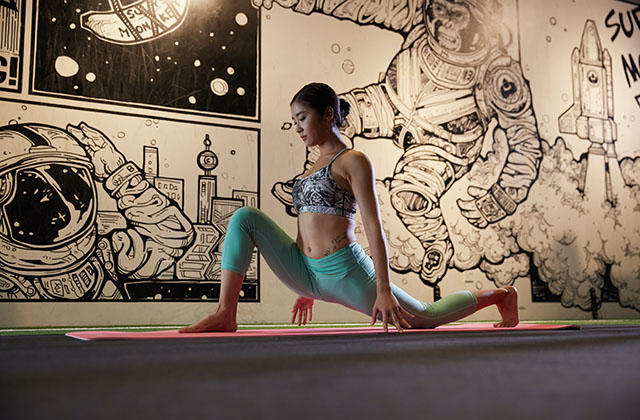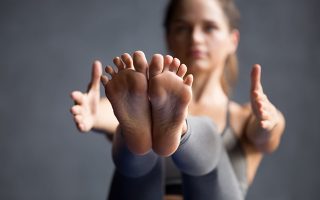Introduction
You’ve heard the old adage, “Don’t jump into the deep end of the pool.” The same goes for your workouts. If you don’t warm up first, your muscles are more likely to tear. So take a few minutes before every workout to get ready with these exercises from Pilates expert Adrienne Wertenbaker, who recommends doing them in this order:
Inhale your arms overhead and exhale as you curl forward.
Inhale your arms overhead and exhale as you curl forward.
Keep the following in mind:
- Inhale as you raise your arms overhead.
- Exhale as you curl forward.
- Keep your back straight, knees soft, shoulders down and head in line with the spine.
- Chin tucked in so that it’s parallel to the floor or lower than the neck when looking down at toes (not tucked so far back that it causes strain on the neck).
Inhale as you return to standing and lift your arms overhead.
- Inhale as you return to standing and lift your arms overhead.
- Keep your spine long, shoulders relaxed and chest lifted as you bring your arms up and over your head. Try not to let them drop back down; this will help keep your upper body open, which is important for proper alignment and posture throughout the stretch.
- Keep your neck relaxed by looking at the ceiling instead of down at the ground, but don’t strain or bend backwards!
- If it feels comfortable for you, try softening or releasing any tension in your legs by bringing them closer together until they are parallel to each other (don’t worry if they don’t touch). To make sure that this works without affecting stability too much, press into the balls of both feet while keeping them pointed forward—this will engage muscles on each side of each leg so that nothing gets unbalanced during this stretch.
Exhale and reach your arms forward, then inhale back down to starting position.
Reach your arms forward, inhaling as you do. As you exhale, slowly lower your arms back down to the starting position. Repeat this exercise several times.
Inhale as you arch back and raise your arms, then exhale and return to center.
Inhale as you arch back and raise your arms, then exhale and return to center. Keep breathing in this way throughout the exercise.
Don’t hold your breath for too long; once you feel that you can’t breathe out any more, continue feeling the stretch but don’t hold it so long that it becomes uncomfortable or painful.
Sweep your arms up until they are over your head, then exhale as you lower them back down.
- Raise your hands overhead, straightening the arms.
- Exhale as you lower your arms back down in front of you, keeping them straight.
Step your feet out from center one at a time to a wide stance, bend your knees and sit back as if sitting into a chair.
- Step your feet out from center one at a time to a wide stance, bend your knees and sit back as if sitting into a chair.
- Keep your back straight, arms straight and head up.
- Keep your knees over your toes with the knees in line with the hips.
- Make sure you have good balance by keeping heels on the floor.
Keeping the ball between your legs, roll back and forth to engage the inner thighs while maintaining control of the ball.
Roll back and forth, keeping the ball squeezed between your inner thighs.
- Keep your knees bent.
- Don’t let your knees go beyond your toes.
- Don’t let your heels come up off the ground.
- Don’t let your back round or reach forward with rounded shoulders as you roll backward, or drop head/shoulders down toward the floor while rolling forward (hint: keep chin tucked).
Inhale as you return to standing and lower the ball down in front of you using both hands with control.
- Inhale as you return to standing and lower the ball down in front of you using both hands with control.
- Don’t let the ball roll out of your hands.
- Don’t let the ball roll out of control.
- Don’t let the ball roll into your body.
- Don’t let the ball roll into your feet.
With your legs shoulder-width apart, lightly hold the sides of the ball overhead with straight arms and roll it slowly forward into a forward bend. Hold for 3 seconds before rolling it back up slowly.
The Pilates Ball Roll is a great way to warm up your spine, shoulders, and hamstrings while increasing your core strength in a safe way. The key is to ensure that you are warmed up before performing any of these exercises. Make sure that your hamstrings are stretched out beforehand so they don’t pull on the lower back muscles during this exercise.
With your legs shoulder-width apart, lightly hold the sides of the ball overhead with straight arms and roll it slowly forward into a forward bend. Hold for 3 seconds before rolling it back up slowly.
To perform this move correctly:
- Keep your back straight throughout—don’t arch or hunch over forward from the waist; try not to let go of either side as you bring it farther back; keep feet flat on floor or just outside hips (never allow knees to pass beyond ankles).
- Don’t roll too far forward—there should be some resistance when pressing hands against floor/ball; don’t let shoulders round forward as if curling chest toward ground; keep neck elongated rather than tucked down (this will help maintain good posture). If pulling on elbow pits causes pain or discomfort in shoulders or neck area while doing this exercise then leave them bent at 90 degrees instead of keeping them straightened out like normal when holding weight overhead (this will protect those areas from being injured).
It is important not to forget about your warmup
It is important not to forget about your warmup. The warm-up will help you prepare for the exercise, as well as keep you injury-free while doing it. A good warm-up can also maximize your workout results by raising body temperature and heart rate. One benefit of Pilates Northern Beaches it restores good breathing patterns.
A proper warm-up should last 10 minutes or more, depending on your fitness level. If you are new to an exercise program, try starting with five minutes of light cardio (such as walking), followed by some dynamic stretches. These are movements that involve mobility in multiple joints, such as arm circles or leg swings; they will get blood flowing through the body while loosening tight muscles and tendons in preparation for an intense training session later on. For example, if you’re planning to do Pilates after stretching and warming up, we recommend starting with a few rounds of “The Hundred”—a series of 100 knee raises in rapid succession—to raise both core strength through resistance training and flexibility through static stretching exercises such as lunges!
Conclusion
So, we’ve covered a lot of ground in this article. We hope that you’re now more aware of the importance of warming up before your workout and how to do it properly. We also gave you some great exercises that are both effective and easy to do at home.




